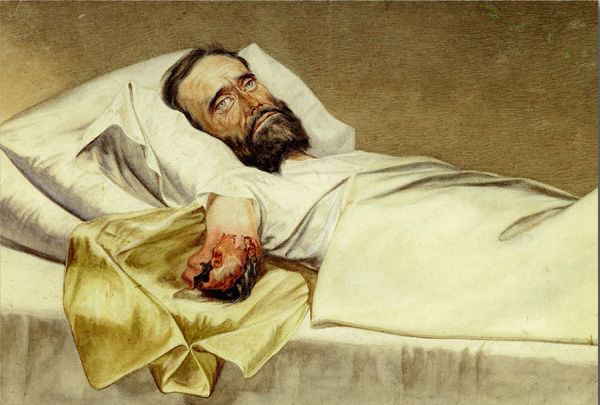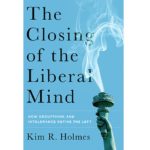You never forget a pile of amputated limbs. Or, at least, Walt Whitman never did.
This grisly sign of war was one of the first sights that greeted Whitman in 1862, when he went to the Civil War battlefield at Fredericksburg, to look for his wounded brother George. As he later recounted it, he saw “a heap of amputated feet, legs, arms, hands, &c.,” a pile so large he described it as “a full load for a one-horse cart.”
For Whitman, this heap of limbs became a representative image of the Civil War, which he imagined as unnaturally cutting off states from the nation. Indeed, the fragmented republic and its piecemeal human bodies weighed heavily upon Whitman, who carried with him the memories of countless amputations and deaths he had seen while volunteering in the military hospitals.
As we approach Memorial Day, a day whose origins lie in the American Civil War, we have an opportunity to reflect on how and why we remember the dead. Walt Whitman offers us his own answer, emerging from his own confrontation with the terrible violence and the human cost of war. For Whitman, memorializing the war in his writing allows him to both recall and “re-member” the broken bodies of the fallen—and in doing so, to act out a kind of healing for them and for their country.
Start your day with Public Discourse
Sign up and get our daily essays sent straight to your inbox.Restoring the Dignity of the Dead
In his writings during and after the Civil War, Whitman recalls the experiences of wounded and dying soldiers in order to restore their dignity and individuality. The massive scale and chaotic nature of the war made accurate record-keeping next to impossible. Countless men suffered and died anonymously, hastily carved up in field hospitals or tumbled into mass graves near the site of battle. By imaginatively recalling the individual experiences of the soldiers in his writing, Whitman could symbolically speak for the many sufferings that would otherwise remain forgotten and untold.
Whitman particularly felt the urgent need to recall the soldiers who suffered and died in the military hospitals, which he called “the Untold and Unwritten History of the War.” Some of the men killed on the battlefield might be remembered in military histories, but the men who died in hospitals from dysentery, infection, and fatal but long-lingering wounds might forever remain anonymous.
In a letter to his mother in 1864, Whitman describes firsthand a heartbreaking example of this kind of personal erasure. While volunteering at the local war hospital, he had witnessed the death of a newly arrived soldier:
they took him into the ward, & the doctor came immediately, but it was all of no use—the worst of it is too that he is entirely unknown—there was nothing on his clothes, or any one with him, to identify him—& he is altogether unknown—Mother, it is enough to rack one’s heart, such things—very likely his folks will never know in the world what has become of him—poor poor child, for he appeared as though he could be but 18….
Apart from a doctor’s brief medical notes—if indeed there were any—Whitman’s letter may very well be the only record in existence of the passing of that young man.
Whitman reacts against this in his poetry, by working to memorialize and recall to his readers the countless forgotten soldiers such as this one. He does this by creating an imaginary personal encounter with them. In his poem “The Wound-Dresser,” Whitman describes just such an unknown wounded soldier, dramatizing a moment of human connection and recognition that some of the lost soldiers never had: “One turns to me his appealing eyes—poor boy! I never knew you, / Yet I think I could not refuse this moment to die for you, if that would save you.” In flashes like these, Whitman’s verse struggles to leave a record, to recall the individual dignity and suffering of men in the war, and to link a face and a person—symbolically, at least—with their unchronicled stories. In the same poem, he describes a soldier with an “amputated hand”:
I undo the clotted lint, remove the slough, wash off the matter and blood,
Back on his pillow the soldier bends with curv’d neck and side falling head,
His eyes are closed, his face is pale, he dares not look on the bloody stump,
And has not yet look’d on it.
Whitman’s amputee soldier remains unnamed, but with a particular description and a highly personal response to his own suffering. His physical and psychological trauma, then, can stand in for that of the countless unnamed soldiers who languished on battlefields and in hospitals during the four long years of the war.
Re-membering the Dismembered
In addition to recalling the anonymous wounded and fallen, Whitman also writes to imaginatively restore their dismembered bodies, to figuratively “re-member” them, and through this process to heal the divided American states. We can see this best in his Civil War memoirs, Memoranda During the War, published ten years after the conflict’s end. Whitman based his book on entries he made in pocket-sized journals that he carried with him during the war, often into the hospitals themselves. In the introduction to the published version, he describes these original notebooks as “blotch’d here and there with more than one bloodstain….” The war was literally written in blood upon his pages.
The word “memoranda” means “things to be remembered.” It is the concluding entry to his Memoranda that best captures Whitman’s re-membering of the dismembered American soldiers and states. In his conclusion, titled “The Million Dead, too, summ’d up—The Unknown,” Whitman grapples with the sheer number of the dead (historians now estimate that between 600,000 and 800,000 men died). But for Whitman what requires comprehension and processing is not merely the number, but the vast spread and scattering of American bodies across the states. “The Dead of this War,” he writes, “there they lie, strewing the fields and woods and valleys and battle-fields of the South….” He describes “the varieties of the strayed dead,” some “carried away by caving-in of banks,” “Some where they crawl’d to die,” “the corpses floated down the rivers, and caught and lodged, (dozens, scores, floated down the Upper Potomac…)—some lie at the bottom of the sea….”
Even a decade after the war, Whitman struggles to make sense of the destruction, as men disintegrate anonymously, hundreds of miles from home, many of their bodies never to be recovered. In a moving passage that approaches a kind of memorial chant, Whitman exclaims: “the dead, the dead, the dead—our dead—or South or North, ours all, (all, all, all, finally dear to me)….” It is as if by repeating himself he can name and remember each one of the “million” dead. As in all of his Civil War writings, Whitman returns again and again to the tragic damage that war wreaks on the bodies of his beloved soldiers, and his language highlights this terrible disintegration: “there, in secluded spots, their skeletons, bleach’d bones, tufts of hair, buttons, fragments of clothing, are occasionally found yet…” What indeed, we might ask, can be gained from the atomizing of men blown and cut and shot into irretrievable pieces?
But for Whitman, these disintegrated, dismembered dead can be—indeed are already being—joined, restored, re-membered through the transformative power of nature. He writes:
the Infinite Dead—(the land entire is saturated, perfumed with their impalpable ashes’ exhalation in Nature’s chemistry distill’d, and shall be so forever, and every grain of wheat and ear of corn, and every flower that grows, and every breath we draw,)—not only Northern dead leavening Southern soil—thousands, aye many tens of thousands, of Southerners, crumble to-day in Northern earth.
Here nature has reunited the human fragments of war—incorporating the broken pieces of men into its life-giving cycle. But more importantly for Whitman, the very amputation and disintegration of these men, scattered in their limbs and bones across both North and South, has in fact brought about the restoration of the Union on an atomic, material level, “and shall be so forever,” he insists. In a reversal of transubstantiation, Northern and Southern soldiers moulder into the earth, becoming new grains of wheat to be consumed by the inheritors of what for Whitman was now a permanently United States.
In his writings, then, Whitman imagines a restoration not only of the disintegrated human body, but of the war-torn and dis-integrated states. By recalling the anonymous suffering of the unknown American soldiers, Whitman wants to restore individuality and personhood to those “hundreds, thousands obliterated” by the violence of war. Memory, for Whitman, both restores dignity and heals wounds, and he seeks to forever re-member those disintegrated dead into the memorial writing of his poems and his Memoranda.
But for Whitman, it is the land itself which remains the most fitting and effective memorial, for it is the land that holds the graves of the dead: “And now, to thought of these,” he concludes his Memoranda, “—on these graves of the dead of the War, as on an altar—to memory of these, or North or South, I close and dedicate my book.”













